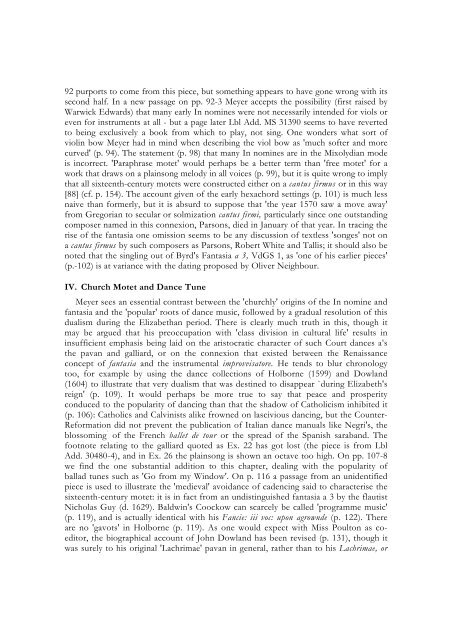You also want an ePaper? Increase the reach of your titles
YUMPU automatically turns print PDFs into web optimized ePapers that Google loves.
92 purports to come from this piece, but something appears to have gone wrong with itssecond half. In a new passage on pp. 92-3 Meyer accepts the possibility (first raised byWarwick Edwards) that many early In nomines were not necessarily intended for viols oreven for instruments at all - but a page later Lbl Add. MS 3<strong>13</strong>90 seems to have revertedto being exclusively a book from which to play, not sing. One wonders what sort ofviolin bow Meyer had in mind when describing the viol bow as 'much softer and morecurved' (p. 94). The statement (p. 98) that many In nomines are in the Mixolydian modeis incorrect. 'Paraphrase motet' would perhaps be a better term than 'free motet' for awork that draws on a plainsong melody in all voices (p. 99), but it is quite wrong to implythat all sixteenth-century motets were constructed either on a cantus firmus or in this way[88] (cf. p. 154). The account given of the early hexachord settings (p. 101) is much lessnaive than formerly, but it is absurd to suppose that 'the year 1570 saw a move away'from Gregorian to secular or solmization cantus firmi, particularly since one outstandingcomposer named in this connexion, Parsons, died in January of that year. In tracing therise of the fantasia one omission seems to be any discussion of textless 'songes' not ona cantus firmus by such composers as Parsons, Robert White and Tallis; it should also benoted that the singling out of Byrd's Fantasia a 3, VdGS 1, as 'one of his earlier pieces'(p.-102) is at variance with the <strong>da</strong>ting proposed by Oliver Neighbour.IV. Church Motet and Dance TuneMeyer sees an essential contrast between the 'churchly' origins of the In nomine andfantasia and the 'popular' roots of <strong>da</strong>nce music, followed by a gradual resolution of thisdualism during the Elizabethan period. There is clearly much truth in this, though itmay be argued that his preoccupation with 'class division in cultural life' results ininsufficient emphasis being laid on the aristocratic character of such Court <strong>da</strong>nces a s sthe pavan and galliard, or on the connexion that existed between the Renaissanceconcept of fantasia and the instrumental improvvisatore. He tends to blur chronologytoo, for example by using the <strong>da</strong>nce collections of Holborne (1599) and Dowland(1604) to illustrate that very dualism that was destined to disappear `during Elizabeth'sreign' (p. 109). It would perhaps be more true to say that peace and prosperityconduced to the popularity of <strong>da</strong>ncing than that the shadow of Catholicism inhibited it(p. 106): Catholics and Calvinists alike frowned on lascivious <strong>da</strong>ncing, but the Counter-Reformation did not prevent the publication of Italian <strong>da</strong>nce manuals like Negri's, theblossoming`of the French ballet de tour or the spread of the Spanish saraband. Thefootnote relating to the galliard quoted as Ex. 22 has got lost (the piece is from LblAdd. 30480-4), and in Ex. 26 the plainsong is shown an octave too high. On pp. 107-8we find the one substantial addition to this chapter, dealing with the popularity ofballad tunes such as 'Go from my Window'. On p. 116 a passage from an unidentifiedpiece is used to illustrate the 'medieval' avoi<strong>da</strong>nce of cadencing said to characterise thesixteenth-century motet: it is in fact from an undistinguished fantasia a 3 by the flautistNicholas Guy (d. 1629). Baldwin's Coockow can scarcely be called 'programme music'(p. 119), and is actually identical with his Fancie: iii voc: upon agrownde (p. 122). Thereare no 'gavots' in Holborne (p. 119). As one would expect with Miss Poulton as coeditor,the biographical account of John Dowland has been revised (p. <strong>13</strong>1), though itwas surely to his original 'Lachrimae' pavan in general, rather than to his Lachrimae, or
















